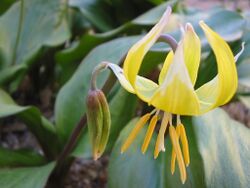Biology:Erythronium tuolumnense
| Tuolumne fawn lily | |
|---|---|

| |
| 'Pagoda', Jardin des Plantes, Paris | |
| Scientific classification | |
| Kingdom: | Plantae |
| Clade: | Tracheophytes |
| Clade: | Angiosperms |
| Clade: | Monocots |
| Order: | Liliales |
| Family: | Liliaceae |
| Subfamily: | Lilioideae |
| Tribe: | Lilieae |
| Genus: | Erythronium |
| Species: | E. tuolumnense
|
| Binomial name | |
| Erythronium tuolumnense Applegate
| |
Erythronium tuolumnense is a species of flowering plant in the family Liliaceae, known by the common name Tuolumne fawn lily or Tuolumne dog's tooth violet. However, it is neither a true lily nor a violet. It is endemic to the Sierra Nevada of Tuolumne County, California; from 600 m (1,969 ft) along Italian Bar Road up to 1,000 m (3,281 ft) altitude at the headwaters of Deer Creek.[2]
This hardy perennial wildflower grows from a bulb 5–10 cm (2–4 in) wide, sometimes with associated bulblets. The bulb resembles a dog's tooth in shape and colour, hence the name "dog's tooth" (which also applies to other erythronium species such as E. dens-canis). It produces two small leaves and a reddish stalk up to 35 cm (14 in) tall bearing one to five flowers. The flower has bright yellow recurved tepals, a white style and white stamens tipped with large yellow anthers.[2][3][4]
This rare plant is threatened by human activity such as logging in its small native range.
Inhabiting moist, light deciduous woodland, this plant is also found in cultivation. The species[5] and the hybrid cultivar 'Pagoda'[6] have gained the Royal Horticultural Society's Award of Garden Merit.
Conservation
Known from only a small number of populations, the largest of which have over ten thousand individuals. Erythronium tuolumnense is listed as imperiled by NaturServe. It has a small historic range, and human activity, especially recreational off-road vehicle use threatens the largest population. Other threats include mining, garbage dumping, camping, logging and fire suppression.[7]
References
- ↑ "Erythronium Tuolumnense". NatureServe Explorer. NatureServe. http://www.natureserve.org/explorer/servlet/NatureServe?searchName=erythronium+tuolumnense+. Retrieved 2018-04-13.
- ↑ 2.0 2.1 Flora of North America v 26 p 159
- ↑ Applegate, Elmer Ivan.. 1930. Contributions from the Dudley Herbarium 1(4): 153–154.
- ↑ Hickman, J. C. 1993. The Jepson Manual: Higher Plants of California 1–1400. University of California Press, Berkeley.
- ↑ "Erythronium tuolumnense". Royal Horticultural Society. http://apps.rhs.org.uk/plantselector/plant?plantid=747. Retrieved 26 July 2013.
- ↑ "Erythronium 'Pagoda'". Royal Horticultural Society. http://apps.rhs.org.uk/plantselector/plant?plantid=745. Retrieved 26 July 2013.
- ↑ "Comprehensive Report Species -" (in en). http://explorer.natureserve.org/servlet/NatureServe?sourceTemplate=tabular_report.wmt&loadTemplate=species_RptComprehensive.wmt&selectedReport=RptComprehensive.wmt&summaryView=tabular_report.wmt&elKey=160447&paging=home&save=true&startIndex=21&nextStartIndex=1&reset=false&offPageSelectedElKey=154772&offPageSelectedElType=species&offPageYesNo=true&post_processes=&radiobutton=radiobutton&selectedIndexes=129316&selectedIndexes=130535&selectedIndexes=156030&selectedIndexes=128967&selectedIndexes=637297&selectedIndexes=154347&selectedIndexes=145575&selectedIndexes=952546&selectedIndexes=145433&selectedIndexes=160447&selectedIndexes=130424&selectedIndexes=143594&selectedIndexes=132698.
External links
Wikidata ☰ Q159899 entry
 |


